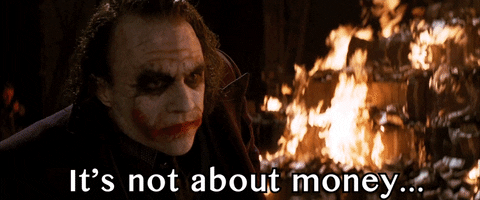Conquer Cash: Your Guide To A Successful No/Low Spend Challenge
At the beginning of the year, we see posts of folks wanting to get their life together - especially when it comes to not only their money but also how much they earn, how they spend, and how they grow throughout the year to come. Whether your “new money” starts in January or June, starting fresh when it comes to your funds is never late. No closed season has many meanings beyond the church.
One of the most popular exercises people tend to do when getting their money stacking right is “No or Low Spend “Challenges. With these, think of the game you used to play back in the day - freeze tag. During these types of challenges, you’re technically doing a spending freeze. YES - no spending a thing.
When you hear “no/low spend, you probably instantly go into a panic about no spending money, but it’s so much more than that:
Save money and pay off debt: The most obvious benefit is saving money! I mean, that’s what you’re probably doing this challenge to do. The saved money from doing this can be used to pay off debt, build an emergency fund, or reach your other financial goals faster.
Boost your awareness of your money: A lot of people have a budget but don’t know how much their life costs. You'll start to track your expenses, identify areas where you can cut back, and gain a better understanding of your financial needs. This is true compound interest.
Break the cycle of impulse buying: A low/no spend challenge can help you break this cycle by forcing you to be more intentional about your purchases. You'll learn to appreciate what you already have and resist the urge to buy things on a whim. Also, unlock your currency cycle (how long money stays in your procession and what impacts it by certain days, etc).
Reduce stress and improve financial wellness (in your wallet): Financial stress can take a toll on your mental and physical health. By taking control of your finances, you can reduce stress and anxiety. You may also find that you have more time and energy for the things that truly matter to you.
Increase gratitude: When you stop buying things on autopilot, you start to appreciate what you already have. This can lead to a greater sense of gratitude and contentment.
Pinpoint why the math isn’t math-ing: When you're limited in your spending, you get creative! You'll find new ways to have fun, entertain yourself, and get what you need without spending money.
Feel a sense of accomplishment: Sticking to a low/no spend challenge can be challenging, but it's also very rewarding. Every day that you stick to your goals is a victory! You'll gain a sense of accomplishment and confidence in your ability to manage your finances.
Getting Started with Your No/Low Spend Challenge:
1. Pick Your Focus:
No-Spend: Go full throttle and eliminate all non-essentials for a set period. Think of it as a financial sprint!
Low-Spend: Set a realistic weekly or monthly budget cap for non-essentials. Think of it as a financial marathon.
Also determine how long are you going to do it: A month or a week.
2. Define "Essentials" + Exemptions:
Make it clear what expenses still count during your challenge. Groceries, rent, bills? Transportation?
Be honest with yourself, but leave some room for flexibility (e.g., occasional birthday gifts).
Look at your budget to determine what’s going on within your money.
3. Stock Up and Plan:
Fill your pantry with staples to avoid unnecessary grocery trips.
Plan fun, free activities for entertainment. Libraries, parks, potlucks - get creative!
Inform family and friends about your challenge for understanding and support.
4. Track and Celebrate:
Use a spending tracker app or a simple spreadsheet to visualize your progress.
Reward yourself for milestones (e.g., a free movie night after a week of no takeout).
Share your journey with friends or online communities for motivation and accountability.
5. Adapt and Adjust:
Don't be afraid to tweak your rules if something isn't working. Flexibility is key.
Unexpected expenses pop up? Evaluate if they're truly essential or find creative solutions.
Remember, challenges are personal. Make it your own and have fun in the process!
Questions to ask yourself throughout the experience:
Do I need that or just want it?
How often will I use this?
Is it a trend or will it add to my life long-term?
Is it good quality?
Do I own something like this already?
Can I thrift this (if it’s clothes)?
The experience (the actual challenge):
Typically you hear about people doing these sorts of challenges by the month, but I wanted to show you it can be personalized to you. I honestly would suggest you do them for no longer than a month if you’re just starting with them. When it comes to setting up how long your “no/low spend” challenge will be, let’s see what they look like in phases:
Sprints (weekend to 1 week):
These are great for beginners: Allows you to test the waters and build momentum without feeling overwhelmed.
Provides quick results: You'll see a noticeable impact on your spending soon, which can be motivating.
Easier to stick to - Less time means fewer opportunities for slip-ups and frustration.
Strides (1-4 weeks):
Offers a good balance: Gives you enough time to make significant progress while still being manageable.
Ideal for specific goals: If you're saving for a short-term goal like a purse or SLG, this timeframe can be perfect.
Requires more planning and commitment: Stock up on essentials and have alternative activities prepared for longer periods.
Marathon (1 month and beyond):
The ultimate test of willpower: Can be an intense but rewarding experience that significantly boosts your financial awareness.
Perfect for major goals: Ideal for saving for a large purchase or paying off debt.
May require significant lifestyle adjustments: You'll need to be creative and disciplined to maintain the challenge for longer periods.
You could start with one area, access how you did, and then determine which works for you. Would also recommend that you start with focusing on one thing - it could be not going to Target for a set amount of time or getting off of Jeff Bezos’ internet for a month. People are starting to remove the apps of convenience to help them save.
Let’s break them down by what level you are to see what other ways you can start a “No/Low Challenge”, pick one and start:
Beginners:
One-Week [ Anything] Freeze: Challenge yourself to avoid eating out or drinking Starbies for a week. Opt for home-cooked meals, picnics in the park, or meal prepping.
Entertainment Flip: Trade expensive movie nights for board game nights with friends, or explore free online resources like educational videos or open-access books.
No Impulse Purchases Week: Resist the urge to buy anything on a whim for a week. Make a list of things you need, and wait at least 24 hours before purchasing anything else.
Intermediate:
Monthly "No-Shop" Experiment: Pick a non-essential category like clothes, shoes, or electronics and avoid buying anything in that category for a month. Get creative with what you already have!
DIY Challenge: Instead of buying new crafts, decorations, or home improvement items, try making them yourself. You'll save money and unleash your inner creative spirit.
Transportation Tweak: Challenge yourself to walk, bike, or use public transportation instead of driving for a week or month. It's good for your health and your wallet!
Advanced:
One-Month Entertainment Blackout: Take a complete break from paid entertainment services like streaming subscriptions, cable TV, and concert tickets. Explore free alternatives like local library events, park activities, or volunteer work.
Cash Only Week: Limit yourself to a fixed amount of cash for the week and stick to it for all purchases. This forces you to prioritize and become more conscious of your spending.
Digital Detox Challenge: Disconnect from social media and online shopping websites for a set period. You'll be surprised how much time and money you save! You can also set limits via your phone to keep you even more focused, and accountable.
Say that you are rewarding yourself for hitting milestones throughout your experience (1 week, 1 month, etc). Here are some examples:
Home Spa Day:
After completing the first week or two, treat yourself to a relaxing home spa day. Use affordable skincare products, take a long bath, and pamper yourself without spending much. Or find a coupon to get either a new product or service, and set a limit.
Cooking Class or Book:
If you've been focusing on cooking at home, reward yourself with a cooking class (many are available online for free) or a new recipe book to expand your culinary skills.
New Plant Baby:
Celebrate a milestone by adding a touch of nature to your home. Buy a new houseplant or a bouquet of fresh flowers to brighten up your living space.
Workout Aufit (Outfit):
You look good, you feel good for everything, especially the gym. If part of your challenge involves prioritizing health and fitness, consider rewarding yourself with a new piece of affordable fitness gear, such as resistance bands, a yoga mat, or a jump rope.
One of the things that people don’t say about “No/Low Spend” Challenges is where do you put the money. I talked about this over on my YT, how anything extra that I save either gets put directly into a bill or debt or saved into my HYSA. So when you finish this challenge, add up your savings (celebrate yourself) and then move that money to grow.
Share with me over on social media what you’re going to do as far as your “No/Low Spend” Challenge or you can comment below about it. This also allows you to find your money formula to make it even better no matter if it’s the beginning or the year or a day that ends in “Y” on some random month.






